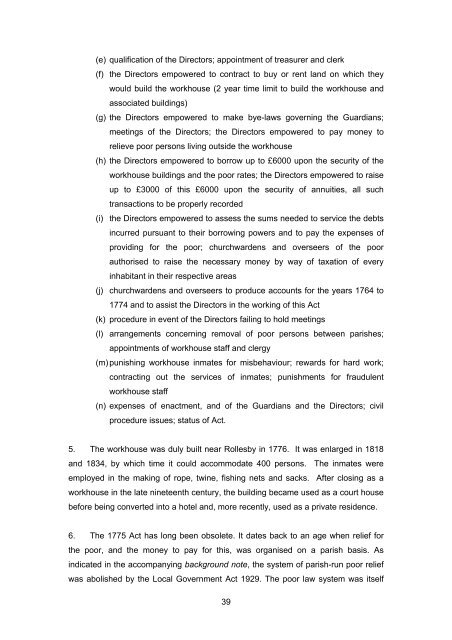Poor Relief - Law Commission
Poor Relief - Law Commission
Poor Relief - Law Commission
You also want an ePaper? Increase the reach of your titles
YUMPU automatically turns print PDFs into web optimized ePapers that Google loves.
(e) qualification of the Directors; appointment of treasurer and clerk<br />
(f) the Directors empowered to contract to buy or rent land on which they<br />
would build the workhouse (2 year time limit to build the workhouse and<br />
associated buildings)<br />
(g) the Directors empowered to make bye-laws governing the Guardians;<br />
meetings of the Directors; the Directors empowered to pay money to<br />
relieve poor persons living outside the workhouse<br />
(h) the Directors empowered to borrow up to £6000 upon the security of the<br />
workhouse buildings and the poor rates; the Directors empowered to raise<br />
up to £3000 of this £6000 upon the security of annuities, all such<br />
transactions to be properly recorded<br />
(i) the Directors empowered to assess the sums needed to service the debts<br />
incurred pursuant to their borrowing powers and to pay the expenses of<br />
providing for the poor; churchwardens and overseers of the poor<br />
authorised to raise the necessary money by way of taxation of every<br />
inhabitant in their respective areas<br />
(j) churchwardens and overseers to produce accounts for the years 1764 to<br />
1774 and to assist the Directors in the working of this Act<br />
(k) procedure in event of the Directors failing to hold meetings<br />
(l) arrangements concerning removal of poor persons between parishes;<br />
appointments of workhouse staff and clergy<br />
(m) punishing workhouse inmates for misbehaviour; rewards for hard work;<br />
contracting out the services of inmates; punishments for fraudulent<br />
workhouse staff<br />
(n) expenses of enactment, and of the Guardians and the Directors; civil<br />
procedure issues; status of Act.<br />
5. The workhouse was duly built near Rollesby in 1776. It was enlarged in 1818<br />
and 1834, by which time it could accommodate 400 persons. The inmates were<br />
employed in the making of rope, twine, fishing nets and sacks. After closing as a<br />
workhouse in the late nineteenth century, the building became used as a court house<br />
before being converted into a hotel and, more recently, used as a private residence.<br />
6. The 1775 Act has long been obsolete. It dates back to an age when relief for<br />
the poor, and the money to pay for this, was organised on a parish basis. As<br />
indicated in the accompanying background note, the system of parish-run poor relief<br />
was abolished by the Local Government Act 1929. The poor law system was itself<br />
39
















